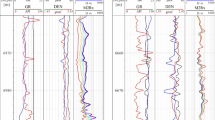Abstract
Well logging is a means of recording the physical, acoustic and electrical properties of the rocks penetrated by a well. It is carried out by service companies, which work under contract for the oil companies. Logging has the advantage that it measures in situ rock properties which cannot be measured in a laboratory from either core samples or cuttings.
Access this chapter
Tax calculation will be finalised at checkout
Purchases are for personal use only
Similar content being viewed by others
Further Reading
Asquith, G. and Krygowski, D. 2004. Basic Well Log Analysis. Methods in Exploration Series 16, AAPG Tulsa, OK, 244 pp.
Coates, G.R., Xiao, L. and Prammer, M.G. 1999. NMR Logging Principles and Application. Halliburton Energy Services Publication H02308, Houston, TX, 234 pp.
Ellis, D.V. and Singer, J.M. 2008. Well Logging for Earth Scientists (2nd ed.). Springer, Dordrecht, 685 pp.
Hepp, V. and Dumestre, A.C. 1975. Cluster—A method for selecting the most probable dip results from dipmeter surveys. SPE Paper 5543, Society of Petroleum Engineers, Dallas, TX.
Hesthemmer, J. and Fossen, H. 1998. The use of dipmeter data to constrain the structural geology of the Gullfaks Field, northern North Sea. Marine and Petroleum Geology 15(6), 549–573.
Mondol, N.H. 2010. Seismic exploration. In: K. Bjørlykke (ed.), Petroleum Geoscience: From Sedimentary Environments to Rock Physics. Springer-Verlag, Berlin. doi: 10.1007/978-3-642-34132-8_17.
Mondol, N.H., Fawad, M., Jahren, J. and Bjørlykke, K. 2008. Synthetic mudstone compaction trends and their use in pore pressure prediction. First Break 26(12), 43–51.
Passey, Q.R., Creaney, S., Kulla, J.B., Moretti, F.J. and Stroud, J.D. 1990. A practical model for organic richness from porosity and resistivity logs. AAPG Bulletin 74(12), 1777–1794.
Pickett, G.R. 1963. Acoustic character logs and their application. Journal of Petroleum Technology 15(6), 659–667.
Plint, A.G., Norris, B. and Donaldson, W. 1990. Revised definitions for the Upper Cretaceous Bad Heart Formation and associated units in the foothills and plains of Alberta and British Columbia. Bulletin of Canadian Petroleum Geology 38(1), 78–88.
Raymer, L.L., Hunt, E.R. and Gardner, J.S. 1980, July. An improved sonic transit time-to-porosity transform. In SPWLA twenty-first annual logging symposium, paper P.
Rider, M.H. 2004. The Geological Interpretation of Well Logs. Blackie, Glasgow, 280 pp.
Wyllie, M.R.J., Gregory, A.R. and Gardner, L.W. 1956. Elastic wave velocities in heterogeneous and porous media. Geophysics 21(1), 41–70.
Author information
Authors and Affiliations
Corresponding author
Editor information
Editors and Affiliations
Rights and permissions
Copyright information
© 2015 Springer Internation Publishing
About this chapter
Cite this chapter
Mondol, N.H. (2015). Well Logging: Principles, Applications and Uncertainties. In: Bjørlykke, K. (eds) Petroleum Geoscience. Springer, Berlin, Heidelberg. https://doi.org/10.1007/978-3-642-34132-8_16
Download citation
DOI: https://doi.org/10.1007/978-3-642-34132-8_16
Publisher Name: Springer, Berlin, Heidelberg
Print ISBN: 978-3-642-34131-1
Online ISBN: 978-3-642-34132-8
eBook Packages: Earth and Environmental ScienceEarth and Environmental Science (R0)




